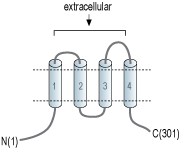Overview
- Synthetic peptide mapping to an extracellular sequence of human Orai1 (Accession Q96D31).

- Eisner, D.A. et al. (2005) Exp.Physiol. 90, 3.
- Chakrabarti, R. and Chakrabarti, R. (2006) J.Cell. Biochem. 99, 1503.
- Feske, S. et al. (2006) Nature 441, 179.
- Pickett, J. (2006) Nature Reviews Mol. Cell Biol. 7, 794.
- Luik, R.M. et al. (2006) J.Cell. Biol. 174, 815.
- Wu, M.M. et al. (2006) J.Cell. Biol. 174, 803.
- Hong H.L. et al. (2007) J. Biol. Chem. 282, 9105.
- Luik, R.M and Lewis, R.S. (2007) Trends Mol. Med. 13, 103.
- DeHaven, W.I. et al. (2007) J. Biol. Chem. 282, 17548.
Cytosolic calcium (Ca2+) has long been known to act as a key second messenger in many intracellular pathways including synaptic transmission, muscle contraction, hormonal secretion, cell growth and proliferation.1,2 The mechanism controlling intracellular Ca2+ level influx either by the calcium-release-activated Ca2+ channels (CRAC), or from intracellular stores, has become of great interest.
Recently, several key players of the store operated complex have been identified3. Orai1 (also known as CRACM1) acts as the store operated Ca2+ channel (SOC) and STIM1, which acts as the endoplasmic reticulum Ca2+ sensor3,4. The formation of functional channels requires the presence of both Orai1 and STIM1 proteins working as a complex and involves the co-clustering of Orai1 on the plasma membrane with STIM1 on the endoplasmic reticulum4-6. TRPC1, a member of the transient receptor potential family was also suggested to act as a player in the SOC complex7. In T-cells, Ca2+ entry following activation by antigen-receptor engagement occurs solely through CRAC channels where Orai1 constitutes the pore forming subunit3,8.
Orai1 is a plasma membrane protein with four potential transmembrane domains and intracellular N- and C-terminus. In addition, two mammalian homologs to Orai1 have been identified; Orai2 and Orai33,9. All three, Orai1 Orai2 and Orai3, are capable of forming store operated channels with different magnitudes9.
Application key:
Species reactivity key:
Mouse Anti-Human Orai1 (extracellular) Antibody (#ALM-025) is a highly specific monoclonal antibody directed against an extracellular epitope of the human Orai1 channel. The antibody can be used in western blot, immunocytochemical and indirect flow cytometry applications and was designed to recognize Orai1 from human samples only.
Mouse Anti-Human Orai1 (extracellular)-Biotin Antibody (#ALM-025-B) is directly labeled with biotin. Strepavidin tagged with HRP or with a fluorescent probe can then be used to detect the protein. The biotin/strepavidin system is ideal for minimizing cross-reactivity when same species antibodies are simultaneously used. Mouse Anti-Human Orai1 (extracellular)-Biotin Antibody has been tested in western blot and direct flow cytometry applications and is specially suited to experiments requiring simultaneous labeling of different markers.


